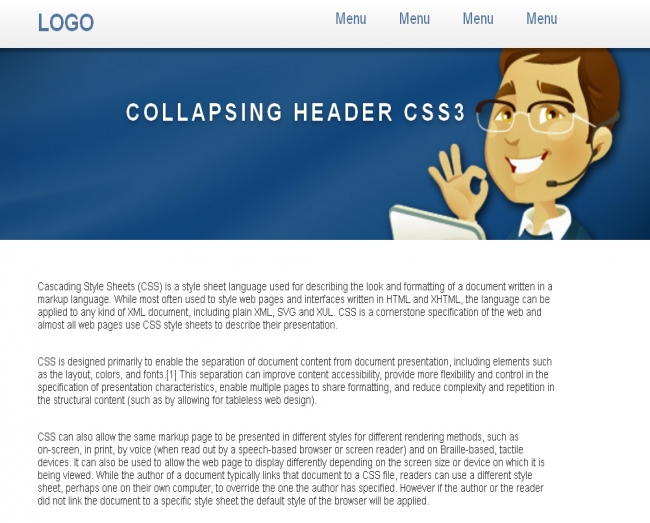Advanced css3 Effects

body, div, h1, h2, h3, h4, h5, h6, p, ul, ol, li, dl, dt, dd, img, form, fieldset, input, textarea, blockquote { margin:0; padding:0; border:0; }
body { background:#fff; font:14px Arial, Helvetica, sans-serif; color:#333; }
a { color:#51749f; text-decoration:none; }
a:hover { color:#274a76; }
header { height:60px; position:fixed; width:100%; background:#ffffff; background:-moz-linear-gradient(top, #ffffff 0%, #eee 100%);
background:-webkit-linear-gradient(top, #ffffff 0%,#eee 100%); box-shadow:0 5px 3px rgba(0,0,0,0.3); z-index:10; }
#head { width:800px; margin:0 auto; padding:10px 0 0 0; overflow:hidden; }
#head h1 { float:left; font-size:30px; text-transform:uppercase; }
#head nav { float:right; }
#head nav li { float:left; font-size:20px; margin:0 0 0 50px; list-style:none; }
#slider { height:300px; position:fixed; background:url(header.jpg); background-size:cover; width:100%; top:60px; }
#slider h2 { margin:50px auto 0; color:#fff; width:800px; font-size:30px; line-height:60px; text-align:center; text-transform:uppercase; letter-spacing:5px;
text-shadow:0 3px 5px rgba(0,0,0,0.3); }
#content { background:#fff; width:100%; position:relative; top:300px; z-index:5; }
article { width:800px; padding:50px 0 0 0; margin:0 auto; }
article p { margin:0 0 30px 0; }
footer { width:100%; background:#333; color:fff; height:50px; }
<div id="container">
<header>
<div id="head"><h1><a href="#">Logo</a></h1>
<nav><ul><li><a href="#">Menu</a></li><li><a href="#">Menu</a></li><li><a href="#">Menu</a></li><li><a href="#">Menu</a></li></ul></nav>
</div>
</header>
<div id="slider"><h2>Header Collapsing Effect</h2></div>
<div id="content">
<article>
<p>Cascading Style Sheets (CSS) is a style sheet language used for describing the look and formatting of a document written in a markup language. While most often used to style web pages and interfaces written in HTML and XHTML, the language can be applied to any kind of XML document, including plain XML, SVG and XUL. CSS is a cornerstone specification of the web and almost all web pages use CSS style sheets to describe their presentation.</p>
<p>CSS is designed primarily to enable the separation of document content from document presentation, including elements such as the layout, colors, and fonts.[1] This separation can improve content accessibility, provide more flexibility and control in the specification of presentation characteristics, enable multiple pages to share formatting, and reduce complexity and repetition in the structural content (such as by allowing for tableless web design).</p>
<p>CSS can also allow the same markup page to be presented in different styles for different rendering methods, such as on-screen, in print, by voice (when read out by a speech-based browser or screen reader) and on Braille-based, tactile devices. It can also be used to allow the web page to display differently depending on the screen size or device on which it is being viewed. While the author of a document typically links that document to a CSS file, readers can use a different style sheet, perhaps one on their own computer, to override the one the author has specified. However if the author or the reader did not link the document to a specific style sheet the default style of the browser will be applied.</p>
<p>CSS specifies a priority scheme to determine which style rules apply if more than one rule matches against a particular element. In this so-called cascade, priorities or weights are calculated and assigned to rules, so that the results are predictable.</p>
<p>Cascading Style Sheets (CSS) is a style sheet language used for describing the look and formatting of a document written in a markup language. While most often used to style web pages and interfaces written in HTML and XHTML, the language can be applied to any kind of XML document, including plain XML, SVG and XUL. CSS is a cornerstone specification of the web and almost all web pages use CSS style sheets to describe their presentation.</p>
<p>CSS is designed primarily to enable the separation of document content from document presentation, including elements such as the layout, colors, and fonts.[1] This separation can improve content accessibility, provide more flexibility and control in the specification of presentation characteristics, enable multiple pages to share formatting, and reduce complexity and repetition in the structural content (such as by allowing for tableless web design).</p>
<p>CSS can also allow the same markup page to be presented in different styles for different rendering methods, such as on-screen, in print, by voice (when read out by a speech-based browser or screen reader) and on Braille-based, tactile devices. It can also be used to allow the web page to display differently depending on the screen size or device on which it is being viewed. While the author of a document typically links that document to a CSS file, readers can use a different style sheet, perhaps one on their own computer, to override the one the author has specified. However if the author or the reader did not link the document to a specific style sheet the default style of the browser will be applied.</p>
<p>CSS specifies a priority scheme to determine which style rules apply if more than one rule matches against a particular element. In this so-called cascade, priorities or weights are calculated and assigned to rules, so that the results are predictable.</p>
</article>
<footer>Footer Links</footer>
</div>
</div>
